I wonder why we don’t pay more attention to roll casting. I can’t count the number of books written about perfecting loops and the overhead cast, but there’s a lot less on roll casting. This, despite the fact that when I’m actually fishing, I find myself rolling over false casting at about a 3-to-1 ratio… at least in most places, and definitely on small streams.
Roll casts are like running plays in football. Not particularly dramatic, but effective and necessary. I often think of overhead casting like the football coach who swore by the ground game by explaining that when you throw the ball, three things can happen and two of them are bad.
Roll casts are like running plays in football. Not particularly dramatic, but effective and necessary.
Why roll cast? Efficiency. Especially with streamers. You let the current do the dirty work. And, by the way, you spook a heck of a lot fewer fish if you’re not constantly false casting overhead.
How to roll cast better? Three things:
One: create surface tension as you start the cast with a low rod tip and accelerate backward.
Two: make sure to let the “D” shape form behind you before you unleash the cast.
Three: as with an overhead cast, stop the rod tip high as you unfurl and shoot, because if you drop the rod tip at the end you take all the energy away.
Do those three things and you’ll be rockin’ and rollin’ wherever you go.
For my money, I think Simon Gawesworth’s Spey Casting is about the best primer you’ll ever read on roll casting. Even though it’s a “Spey” book, the basic principles start with the simple roll, and it’s not against the rules by any stretch to apply some fancy spey moves with a single-handed rod.
But that’s a different discussion for a different day.



